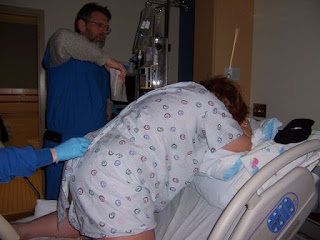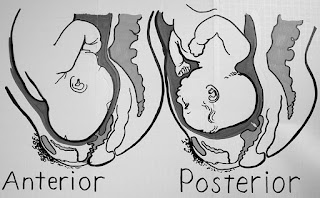There is a lot on the blog-o-sphere lately about the failure of maternal positions to rotate the posterior baby. My point is that we can’t say maternal positions aren’t useful to help a baby rotate until we get smart about which positions to study.
 |
| Hands and knees is a comfort measure but no longer thought of as the position to rotate a posterior baby to anterior. |
 |
| The posterior baby’s chin is up making the top of the head enter the pelvis instead of the smaller “crown” of the anterior and flexed baby. |
There are empowered labor and delivery nurses, doulas, and midwives everywhere that have their “swear by” positions.
“oh, we just do this…” they’ll say and go on to dehttps://www.spinningbabies.com/wp-content/uploads/2019/10/sample3-1.png a position they put a mom in over a peanut ball or the rolling hospital lunch tray, a pile of pillows or off the bed. It’s happening all over.
Why don’t these tips and tricks show up in the literature?
The positions studied are the ones most easy to train and replicate. Throw a leg over a pile of pillows… ok, and the person does it in such a way that is most comfy for mom. The nurse will correct, “oh, no, that won’t do, put the pillows higher, bring that leg up higher and bring that hip up and around…”
Or, “no, put that roll under the trochanters, not the sacrum.”
Many nurses develop a 6th sense about maternal positions and figured out some way to position mothers based on a birth they saw a dramatic change. Repeating it, they saw it work again.
The invented positions are often quirky. One midwife showed me a complicated dance of having a woman gently fall into the wall in front of her from standing back away from the wall. She was to do it in a sinewy way that rocked her pelvis to engage the baby. Nurses and a chiropractor showed me how a kneeling women could lift and press the baby’s head just above her pubic bone while rising to jut her belly out to help engage a baby. There are as many tricks as crones. Observation is a great teacher.
Positions studied are often hands-and-knees, or a variation on the yoga position called “child’s pose” but in this position, the brim is neutral or closed. Dr.s Anke Reitter and Andrew Bisits worked with Betty-Anne Daviss to study a position they recommend to measure the effect on the pelvis inlet but the MRI machine didn’t have room for the mother in that position. So they studied the pose she could do in the restricted space – and found a different part of the pelvis widening (Reitter). (Good studies show something useful even if not able to follow through with the original intent.) We can say more studies are needed, but really, we have studies on squatting, Walcher’s, child’s pose, lithotomy, semi sitting, McRoberts, and now a kneeling position with knees wide apart.
We have a funny way in our country of saying, well, we want everything we recommend to be evidence-based (and yet so much practice continues which is against the evidence). In this model, we assume everything good is studied and if it isn’t studied, well, then it must not be worth studying. And yet how few women are allowed off their backs to birth their babies even when they request an upright position. Something worthy has been studied but the benefits are still not available.
Other worthy approaches may not be studied because complex processes aren’t always feasible to study. The mother doesn’t fit in that pose in an MRI machine or the position is more of a technique or even a string of techniques. Posterior presentation may be a result of a number of variables and babies can get stalled in their way down the pelvis at different levels of the pelvis where different moves or positions are needed to create room.
Trying to study something that takes 3 or 6 steps to complete is not going to get studied. Something that takes one step will get studied – especially if it has been studied before. “Which one of those steps will show the most effect?” Imaging stu asdying stair climbing and have the research team ask which one of those stairs will bring you to the top fastest, because, seriously who has the time to walk up each one of them? That’s too expensive to study. Can’t you pick the best step?
But until we get it figured out that isolating one position isn’t going to solve the need to make room in a 3 level pelvis (and I might argue 4 levels when we think of the disengaged Right Occiput Posterior baby at – 2 station) we can at least pick a position that corresponds to the need a posterior baby has to enter the pelvis. It’s “pretty easy” to help a posterior baby rotate while above the brim but it takes a series of techniques for most women.
If the baby just needs a little room, the abdominal lift and tuck will do… oops, that’s two things, can we study that? Maybe not, so Walcher’s -has been studied a few times. A tough position for most women, but most effective for one technique.
If the baby is in the pelvis but not fully engaged and posterior, I call this a misengagement. Backing the baby out and letting baby have room is a process as well, not a single technique. Better not study that, then. Too complicated.
Ok, then, how about the outlet? The posterior baby in the outlet trying to fit out. Hands and knees might be better than on the back, but a birthing stool is really great. Oh, wait, too many moms on epidurals, the study population will be too low. Ok, the peanut ball! That’ll be great, we expect good results.
The technique studied, though opens the inlet and now we want to see how to open the outlet because the baby is low. Oh, you didn’t know there was a different technique for that? Yep. Let’s save the knees apart for when baby is still high and put the knees together with feet apart for when baby is truly low. Beware the false engagement of the posterior dome and don’t miss finding that over lapping head.
You see, sorting out the posterior can take a little more “real life” than applying one simple technique.
The current recommendation for posterior is if the baby isn’t coming, the doctor reaches in and turns the baby by hand. While this is a technique to keep handy (mind my pun, don’t step in it) its recommended also because it fits the approach of what we can do. What We can do, meaning providers. Its a use of force. Where as addressing the soft tissue “shape” of the pelvis isn’t spoken of in the obstetric or midwifery conversation.
Let’s make room for the mother by adding length in the muscles to her pelvis with some static stretch techniques and then move the legs and lower back in a particular way, not randomly through our pelvic playlists. There is a method to the mystery.
I get specific in the Quick Reference Guide, a handy download to print yourself or buy already printed. What to do when is listed in the Quick Reference.
One of our most beloved products, now with subtitles in English, French, and Spanish, offering expert support to reduce intervention and increase comfort throughout pregnancy and birth.